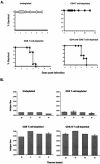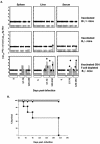Persistent infection with ebola virus under conditions of partial immunity
- PMID: 14694127
- PMCID: PMC368745
- DOI: 10.1128/jvi.78.2.958-967.2004
Persistent infection with ebola virus under conditions of partial immunity
Abstract
Ebola hemorrhagic fever in humans is associated with high mortality; however, some infected hosts clear the virus and recover. The mechanisms by which this occurs and the correlates of protective immunity are not well defined. Using a mouse model, we determined the role of the immune system in clearance of and protection against Ebola virus. All CD8 T-cell-deficient mice succumbed to subcutaneous infection and had high viral antigen titers in tissues, whereas mice deficient in B cells or CD4 T cells cleared infection and survived, suggesting that CD8 T cells, independent of CD4 T cells and antibodies, are critical to protection against subcutaneous Ebola virus infection. B-cell-deficient mice that survived the primary subcutaneous infection (vaccinated mice) transiently depleted or not depleted of CD4 T cells also survived lethal intraperitoneal rechallenge for >/==" BORDER="0">25 days. However, all vaccinated B-cell-deficient mice depleted of CD8 T cells had high viral antigen titers in tissues following intraperitoneal rechallenge and died within 6 days, suggesting that memory CD8 T cells by themselves can protect mice from early death. Surprisingly, vaccinated B-cell-deficient mice, after initially clearing the infection, were found to have viral antigens in tissues later (day 120 to 150 post-intraperitoneal infection). Furthermore, following intraperitoneal rechallenge, vaccinated B-cell-deficient mice that were transiently depleted of CD4 T cells had high levels of viral antigen in tissues earlier (days 50 to 70) than vaccinated undepleted mice. This demonstrates that under certain immunodeficiency conditions, Ebola virus can persist and that loss of primed CD4 T cells accelerates the course of persistent infections. These data show that CD8 T cells play an important role in protection against acute disease, while both CD4 T cells and antibodies are required for long-term protection, and they provide evidence of persistent infection by Ebola virus suggesting that under certain conditions of immunodeficiency a host can harbor virus for prolonged periods, potentially acting as a reservoir.
Figures






References
-
- Accorsi, S., M. Fabiani, M. Lukwiya, P. A. Onek, P. D. Mattei, and S. Declich. 2001. The increasing burden of infectious diseases on hospital services at St Mary's Hospital Lacor, Gulu, Uganda. Am. J. Trop. Med. Hyg. 64:154-158. - PubMed
-
- Anonymous. 1990. Update Filovirus infections among persons with occupational exposure to nonhuman primates. Morb. Mortal. Wkly. Rep. 39:273. - PubMed
-
- Baize, S., E. M. Leroy, M. C. Georges-Courbot, M. Capron, J. Lansoud-Soukate, P. Debre, S. P. Fisher-Hoch, J. B. McCormick, and A. J. Georges. 1999. Defective humoral responses and extensive intravascular apoptosis are associated with fatal outcome in Ebola virus-infected patients. Nat. Med. 5:423-426. - PubMed
MeSH terms
LinkOut - more resources
Full Text Sources
Medical
Research Materials

